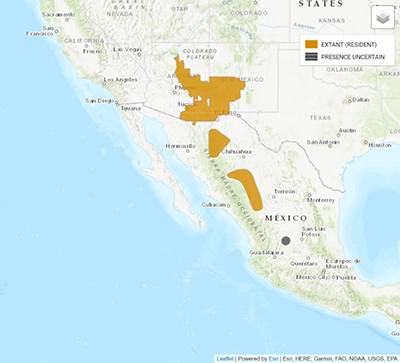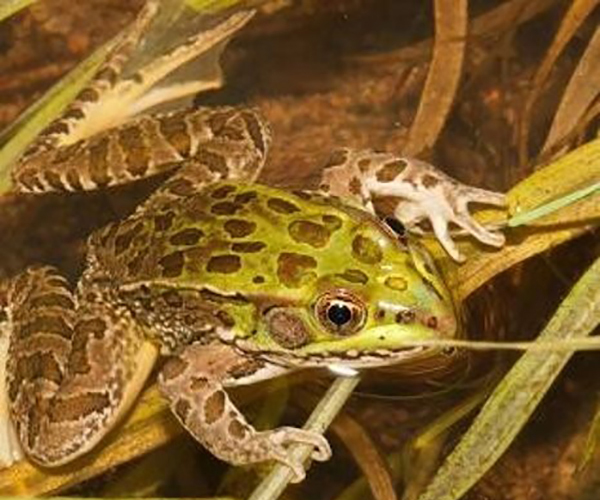Chiricahua Leopard Frog

About
HONKshooooo! HONKshooooo! Who’s that snoring? It’s a Chiricahua leopard frog! These frogs have a snore-like call that can be heard near perennial water in Arizona, New Mexico, and Mexico. Called leopard frogs due to dark dots resembling that of the large cat, these uniquely spotted frogs can range in color from green to brown with golden eyes. Chiricahua leopard frogs are stocky and range 2-4 inches in length. Females are bigger than males as adults.
Adaptations
These green and brown spotty frogs have great natural camouflage for blending into their surroundings. They can even darken skin on their back depending on the temperature and light conditions!
Food Web
As tadpoles, leopard frogs eat very small organisms ranging from bacteria to plants. As adults, they are carnivorous, eating small fish and invertebrates such as beetles, true bugs, flies, and even snails.

Habitat and Range
The Chiricahua leopard frog is found in a variety of habitats and elevations and will be found in or near water. Found in Arizona, New Mexico, and Mexico, this species is split into two identified subpopulations — a montane subpopulation along the Mogollon Rim in center-Eastern Arizona and center-Western New Mexico, and a subpopulation in the mountains and valleys of Southeastern Arizona, Southwestern New Mexico, and down into Mexico. Chiricahua leopard frogs can be found in elevations ranging from 3,280 to 8,600 feet.
IUCN (International Union for Conservation of Nature), Conservation International, NatureServe & CONABIO (Comisión Nacional para el Conocimiento y Uso de la Biodiversidad) 2020. Lithobates chiricahuensis. The IUCN Red List of Threatened Species. Version 2022-2

Family Life
Permanent or semi-permanent water sources — such as springs, rivers, lakes, and cienegas — with low pollution levels are required for Chiricahua leopard frogs to live and reproduce. Leopard frogs may breed year-round and lay eggs in clumped masses near the water’s surface. Tadpoles get very large as they may take more than a year to metamorphose. Post metamorphosis, sexual maturity is reached in 2-3 years. This species can live 14-18 years in the wild!
Glossary
- Perennial:
- Persistent or continually recurring.
- Carnivorous:
- Only feeding on other animals.
- Invertebrate:
- An animal that does not have a backbone.
- Metamorphose:
- To change form from one life stage to another.
- Subpopulation:
- Subset of a larger population.
Fun Facts
- This frog’s call sounds like snoring. Listen!
- Leopard frogs can make a calling sound below water, which is unusual for amphibians.
- Highly aquatic, they often jump into water from the streambank to avoid capture.
- Chiricahua leopard frogs are an indicator species that can help identify water quality issues.
Conservation
- In 2002 the Chiricahua Leopard Frog was listed as Threatened under the Endangered Species Act.
- Arizona Game and Fish prohibits collection of this species from the wild in Arizona.
IUCN SSC Amphibian Specialist Group. 2022. Lithobates chiricahuensis. The IUCN Red List of Threatened Species 2022: e.T222289521A53970247. https://dx.doi.org/10.2305/IUCN.UK.2022-2.RLTS.T222289521A53970247.en. Accessed on 13 October 2023.
At The Museum
View on Map

See Leopard frogs at Life on the Rocks.
2000-2010: The Museum worked with several populations of Chiricahua leopard frogs that were in peril. The work consisted of breeding frogs that came from drying out cattle ponds. The Museum was able to return the adults and young frogs back into their original locations.
Challenges
- In Arizona, the Chiricahua Leopard Frog has declined more than any other leopard frog.
- Habitat loss accounts for an 80% decline in the population.
- These frogs need permanent sources of water for reproduction.
- Water sources are impacted by groundwater pumping, livestock, and introduced species that prey on them or bring in diseases.
- With increased temperatures, climate change is worsening drought conditions and affecting already fragile water habitats.










